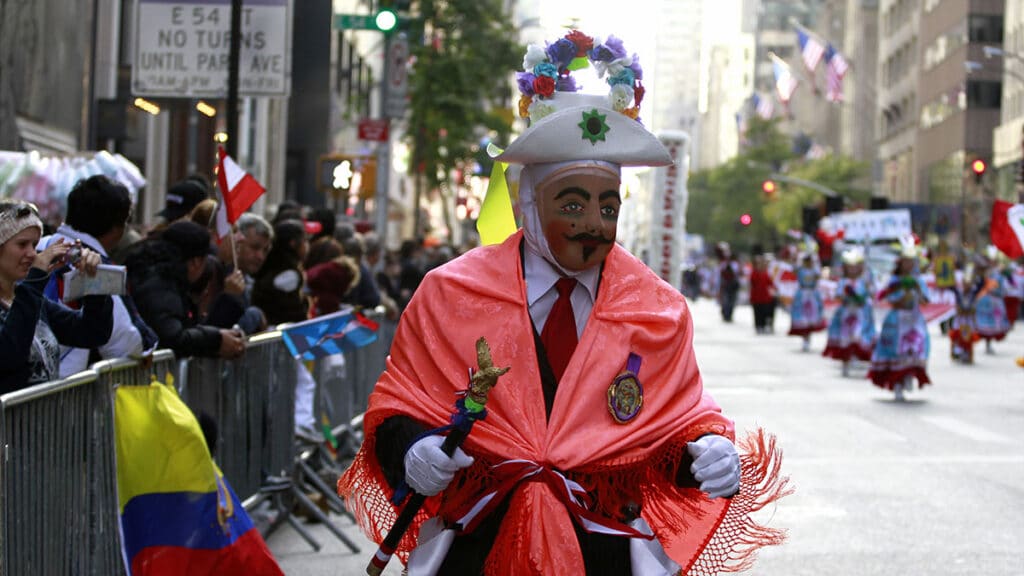
The Hispanic Day Parade NYC 2024 Desfile de la Hispanidad New York is New York City’s big Hispanic Heritage Month celebration. It’s a wonderful example of the incredible diversity of what we now call Latin or Hispanic countries.
Hispanic Day Parade NYC 2024
The 60th Hispanic Day Parade NYC 2024 Desfile de la Hispanidad New York marches up Fifth Avenue from 44th to 69th St, from Midtown/Midtown East to Central Park/Upper East Side; on Sunday, October 13, 2024 at 12 noon. 🇦🇷🇧🇴🇨🇱🇨🇴🇨🇷🇨🇺🇩🇴🇪🇨🇸🇻🇬🇹🇭🇳🇲🇽🇳🇮🇵🇦🇵🇾🇵🇪🇵🇷🇪🇸🇺🇾🇻🇪
Hispanic Day Parade NYC
The Hispanic Day Parade NYC Desfile de la Hispanidad fills Fifth Avenue with folkloric Hispanic dances and traditions. Like all parades, it’s a chance to teach our American children about their heritage, celebrate our contributions to American culture, get attention from politicians, and basically have a good time together. That’s really important now that social media is replacing traditional culture. Knowing our heritage also makes us better Americans.
Hispanic is More Than You Think
Some think Latin or Hispanic is one thing, but it’s actually many, many things. Hispanic culture is far more diverse than most people think.
There are nineteen Spanish-speaking countries in the Americas, twenty if you include the United States, which has the world’s second-largest Spanish-speaking population of over 50 million. Two-thirds of the USA was once New Spain / Mexico, so Spanish is native here too. According to the Pew Research Center, there were 63.7 million Hispanics in the United States in 2022.
Of course, there is Spain and its territories, including the Canary Islands. In Africa, Equatorial Guinea was colonized by several European countries, but lastly by Spain as Spanish Guinea. Spanish is one of its official languages. Interestingly, Spanish is respected in Saudi Arabia because Spain was once Arab al-Andalus.
There are many Hispanic cultures, but each is defined by its own unique blend of geography, history, and peoples. There is also lots of variation within countries by region, city or town, neighborhood, and even by family. For example, in the United States, both Mexican and Puerto Rican cultures are Hispanic, but they are unique. Puerto Ricans from The Bronx, San Juan, and Ponce are all a little different from each other ~ but still Puerto Rican.
Aside from Spain, the colonizer, all Hispanic countries have been colonized. The Americas were originally all Indigenous. Then the Spanish came and brought Africans. So there is African Diasporic culture ~ even in places you might not expect it, like Mexico, Bolivia, and Peru for example. In some countries, Africans eventually blended in, and in others remain distinct communities.
Some people brought from Africa brought Arab traditions with them. The pandereta used in Puerto Rican plena is originally an Arab drum. There has been a lot of Lebanese, Palestinian, and Jewish immigration to the Caribbean and Latin America as well. Quipes, a fried food in the Dominican Republic, is a Caribbean form of Mediterranean falafel. Some Dominicans have Lebanese last names. Shakira, the Colombian pop singer, is also of Lebanese descent.
The Philippines was on the other end of the Pacific Spanish Galleon route, and after emancipation the colonizers brought indentured workers from what is now China and South Asia (India), so there is Asian influence as well. You see that in New York City’s Spanish-Chinese restaurants. Those are run by Chinese Cuban families. There were also more recent migrations from China and Japan. Peruvian ceviche is so delicious partly because Japanese flavors brought by Japanese chefs in Peru.
So Hispanic in the Americas is not one thing. It’s many things with influences from the entire world.
- Argentina 🇦🇷
- Bolivia 🇧🇴
- Chile 🇨🇱
- Colombia 🇨🇴
- Costa Rica 🇨🇷
- Cuba 🇨🇺
- Dominican Republic 🇩🇴
- Ecuador 🇪🇨
- El Salvador 🇸🇻
- Guatemala 🇬🇹
- Honduras 🇭🇳
- Mexico 🇲🇽
- Nicaragua 🇳🇮
- Panama 🇵🇦
- Paraguay 🇵🇾
- Peru 🇵🇪
- Puerto Rico 🇵🇷
- Spain 🇪🇸
- United States 🇺🇸
- Uruguay 🇺🇾
- Venezuela 🇻🇪
Information
Facebook @desfile.hispanidad.56
